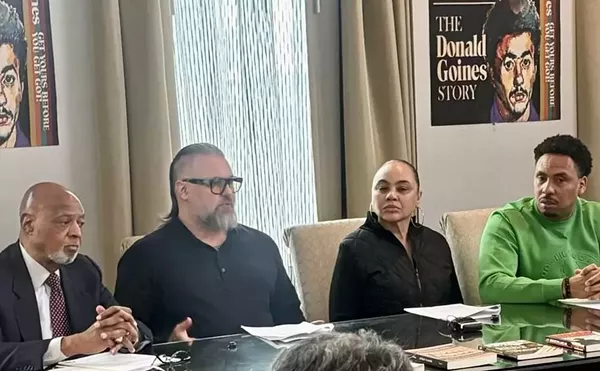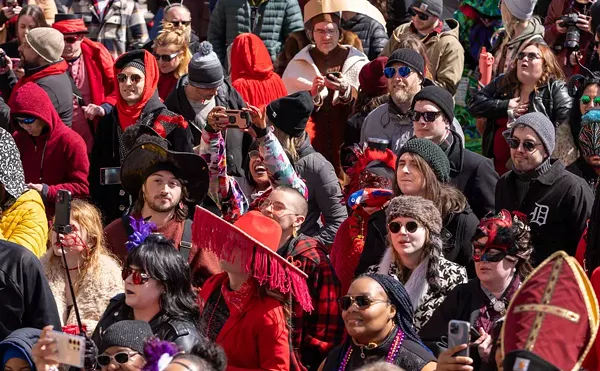Quick: Name a movie that has no "extras" — absolutely no one in the background to help create the illusion that the scenes take place in the real world. Tough, huh? Extras are the plankton of the acting world's food chain: taken for granted, but very, very necessary.
Godzilla is not a documentary. We know that the giant lizard is a performer in a rubber suit. We know Tokyo is just a series of balsa wood and cardboard models smashed by the performer in the rubber suit. It's completely fake. So the only thing that gives us the "Oh, shit — a giant radioactive lizard stomping through my town would suck!" feeling is the real people really running past relatively real structures with looks of real terror.
The same basically applies to Transformers 5, shooting now in Detroit as one of its multiple global locations. T5 has tapped hundreds of local people to play various extra and background roles. For clarification, background and extra are virtually interchangeable terms for performers with no audible or scripted lines of dialogue. In some cases, a performer will be asked to do a specific thing, such as mow a lawn or hail a cab. In that case, they are considered "featured extras."
When people explore "becoming" an extra, it's usually for one of three reasons: 1) A movie star they admire, respect, or want to have sex with is filming in town, and they would like to meet that person; 2) they just lost their job after 17 years and they need what they perceive as a quick way to make a few bucks; 3) they are aspiring or even "wannabe" actors. To oversimplify for all groups, the experience of being an extra can be explained something like this:
You sit around all day, choke on grab-and-go pizza, change in a pop-up tent in a gravel parking lot, get no autographs (autograph requests are heavily frowned upon; unauthorized photos can get you fired), make $8 an hour and then all your friends pay $12 to see the movie, and most of them lie and tell you they really did see your purple barrette 15 people deep behind Mark Wahlberg when he's walking down the street.
This description never seems to dissuade those who have "appearing in a movie" on their bucket list. Similar to bungee jumping, it can either be the kind of experience you wish you hadn't signed on for or it can change your life. But odds are that it will just be a story, much like how you first bedded grandma, that your grandkids will get tired of hearing the third time you tell it.
As far as making a buck, it's rarely quick. Most days last a minimum of eight hours, and it's not unheard of to do 16. Most of them are spent sitting or even standing, waiting for group instructions. And like the military or a school sports team, if one person screws up the instructions, the entire group must repeat the process.
Local musician John Quiroz got booked as background on the latest installment of Transformers. His biggest fear is "working those long hours and the scene getting cut thanks to editing," which happened to him after working on the horror classic Phantasm reboot in Los Angeles in the 1980s. He does describe his Transformers experience as "fun" despite less-than-ideal conditions.
"It was almost 100 degrees out on the T5 set, and the scene called for springtime wardrobe, complete with sweater vests and leather jackets. It was hot, but we all soldiered on," he says.
Quiroz describes the talent level needed to be a background performer as "almost acting."
"You just have to know how to pretend and be smart enough not to look directly in the camera."
Detroit native Sean Sweeney, armed with a BFA in theater from Wayne State University, headed to New York after graduation, presumably knowing a thing or two about acting and booked a role on Six Feet Under. The role was subsequently downgraded to that of an extra. He accepted it anyway, employing the philosophy that at least he was on set, where one can get noticed, meet people, and make connections — and that he could use the money, though a downgrade from a speaking role to an extra is a precipitous drop. Today's rate for speaking performers in Screen Actors Guild film projects is $906 per day. Extras rarely make more than $140.
Sweeney has gone on to a successful commercial career, appearing in spots for telecommunications providers and major beer brands.
Kathi Moore of Waterford was selling real estate during the 2008 downturn when a friend suggested she could pick up some pocket change by signing up with an agency to be an extra or background performer. She had no previous film or acting experience. After turning down a few bookings, she finally said yes to a background part in Miss January (which would be released as Meet Monica Velour), shooting in the Detroit area. The 2010 film stars Kim Cattrall as an aging porn actress.
"I did as I was instructed and went to a location I didn't know existed: downtown Romulus. We were given very specific instructions not to approach or harass the main talent [Cattrall], then 15 minutes later I was being instructed to enter a [vintage] barbershop and improvise a fight with Miss Cattrall. So I did. After about 15 or 20 minutes of improvising, a man in a straw hat approached. [I was so new] I had no idea this was the director [Keith Bearden]. He told us to scream and yell and have a good fight. So we did," Moore says.
"When it came time for the actual shot, the assistant director told me to mime my part," Moore says. (This is a common practice for background performers so that the production is not contractually obligated to pay the extras the higher "speaking" rate.) "So I did. Moments later, the man in the straw hat came marching toward us rather hastily. "Why can't I hear her?" After some discussion, they consulted the star.
"Is it better if she talks or mimes?"
"It's much better if she speaks," Cattrall said with a wink. And with that wink, the petite real estate agent, in her first hour on a movie set, was "bumped" (industry parlance for being elevated to a "real" acting part). While not rare enough to be the "holy grail" of the extra world, it's nonetheless a coveted chalice from which to sip while one moves to the grown-up table of a legitimate and often credited role.
"The assistant director was saying, 'Congratulations, sweetheart, ya got a contract.' Cattrall said, 'Give me a high-five.' A few more takes and a pile of paperwork later, I was a paid actor. I could hardly believe it. I convinced one of my realtor friends to join me on the next gig. We worked 16 hours and were fed day-old bagels and oranges so old you couldn't peel them. I guess it's all about balance," Moore says.
Despite the loss of the film tax incentive, there are still a handful of feature film, music video, and television projects that shoot in and around the Motor City, notably, Comedy Central's Detroiters, starring area natives Tim Robinson and Sam Richardson, and produced by Saturday Night Live alum Jason Sudeikis. If you think you would like to be an extra in any local productions, see rsol.us/reel-extras or ryanhillcasting.com.
And much like a film, TV, or video set: Follow the damn directions.
Jimmy Doom is a frequent MT contributor and Detroiter who acts, writes, and screams at TVs during sporting events.








